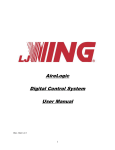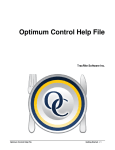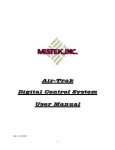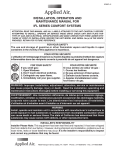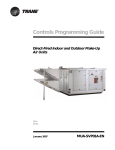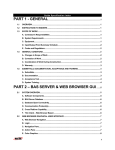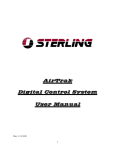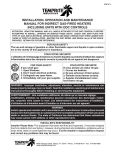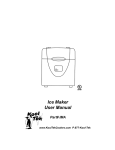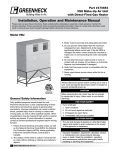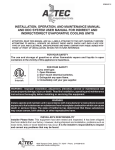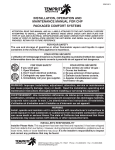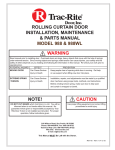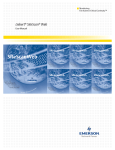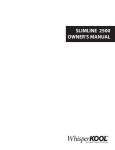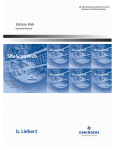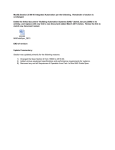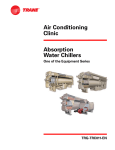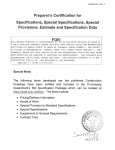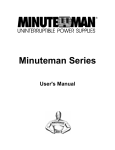Download TracRite Digital Control System User Manual
Transcript
TracRite Digital Control System User Manual Rev. 10-22-07 1 Table of Contents OVERVIEW................................................................................................................. 6 NETWORKING..................................................................................................... 7 TRACRITE DEFAULT SETTINGS ...................................... 7 UNIT OPERATING MODES ........................................................... 8 MDT Controls: ........................................................................................................................... 8 UNIT OFF MODE ............................................................................................................................................... 8 UNIT MANUAL MODE ..................................................................................................................................... 8 UNIT AUTO MODE ........................................................................................................................................... 8 MRT Controls: ........................................................................................................................... 9 UNIT OFF MODE ............................................................................................................................................... 9 UNIT MANUAL MODE ..................................................................................................................................... 9 UNIT AUTO MODE ........................................................................................................................................... 9 MRT-Pro Controls: ................................................................................................................... 9 UNIT OFF MODE ............................................................................................................................................... 9 UNIT MANUAL MODE ..................................................................................................................................... 9 UNIT AUTO MODE ........................................................................................................................................... 9 Unoccupied/Occupied Control............................................................................................................................. 9 Scheduling Time Clock....................................................................................................................................... 10 Heating Night Setback ....................................................................................................................................... 10 Cooling Night Setback ....................................................................................................................................... 10 Auxiliary Unit Enable ........................................................................................................................................ 10 MRT-Expert Controls: ............................................................................................................ 10 UNIT OFF MODE ............................................................................................................................................. 11 UNIT MANUAL MODE ................................................................................................................................... 11 UNIT AUTO MODE ......................................................................................................................................... 11 Scheduling Time Clock....................................................................................................................................... 11 Heating Night Setback ....................................................................................................................................... 12 Cooling Night Setback ....................................................................................................................................... 12 Auxiliary Unit Enable ........................................................................................................................................ 12 VDT-Expert Controls:............................................................................................................. 12 UNIT OFF MODE ............................................................................................................................................. 12 UNIT MANUAL MODE ................................................................................................................................... 12 UNIT AUTO MODE ......................................................................................................................................... 12 Scheduling Time Clock....................................................................................................................................... 13 Auxiliary Unit Enable ........................................................................................................................................ 13 Heating/Ventilating/Cooling Operating Modes ............................................................................................................................... 13 Heating Mode.......................................................................................................................... 14 General Burner Control ...................................................................................................................................... 14 Recirculating Direct-Fired Heaters ................................................................................................................... 15 2 Energy Savings Mode 1 Mixing Box Recirculating Units ............................................................................. 15 Energy Savings Mode 1 Non-Recirculating Units ......................................................................................... 16 Energy Savings Mode 2 Mixing Box Recirculating Direct-Fired Units......................................................... 16 Energy Savings Mode 3 ..................................................................................................................................... 16 Ventilation Mode ..................................................................................................................... 16 Cooling Mode .......................................................................................................................... 18 Energy Savings Mode 4 ..................................................................................................................................... 19 Damper Control Modes.................................................................... 20 Manual Mode .......................................................................................................................... 20 MDT, MRT, and MRT-Pro Controls ................................................................................................................. 20 MRT-Expert Control .......................................................................................................................................... 20 Mixed Air Temperature Mode ............................................................................................... 20 MDT, MRT, and MRT-Pro Controls ................................................................................................................. 20 MRT-Expert Control .......................................................................................................................................... 21 Building Pressure Mode ........................................................................................................ 21 MDT, MRT, and MRT-Pro Controls ................................................................................................................. 21 MRT-Expert Control .......................................................................................................................................... 21 100% Outside Air........................................................................................ 21 Minimum Ventilation ........................................................................... 21 Freezestat................................................................................................................ 22 Clogged Filter ................................................................................................... 22 User Configured PID Control ................................................ 22 DIRECT ACTING ................................................................................................................... 23 REVERSE ACTING ............................................................................................................... 24 Unit Resets ............................................................................................................ 26 ALARM ..................................................................................................................................... 26 CALIBRATE ............................................................................................................................ 26 FAN COUNT ........................................................................................................................... 26 HEATING COUNT ................................................................................................................. 26 COOLING COUNT ................................................................................................................. 26 Multiplexed Inputs ................................................................................... 27 3 Clock Set ................................................................................................................... 27 Diagnostics – Critical Fault Codes............................ 27 FAULT CODE: Low Discharge Temperature ................................................................... 27 SOLUTION: SOLUTION: If burner was operating prior to shutdown (check prior alarm log) ....................................... 27 If burner was not operating prior to shutdown (check prior alarm log) ................................. 29 FAULT CODE: Safety Circuit Open ................................................................................... 30 SOLUTION: SOLUTION: If fan is not running (check prior alarm log) ......................................................................... 30 If fan is running (check prior alarm log) ............................................................................... 31 FAULT CODE: Burner Status ............................................................................................. 31 SOLUTION: Inspect burner control circuit and burner.............................................................................. 31 FAULT CODE: Burner Hand ............................................................................................... 32 SOLUTION: Inspect burner control circuit. This fault has the potential to be a very serious problem. Close the manual gas valves immediately if the fan is not running. .................................................................. 32 FAULT CODE: Flame Failure ............................................................................................. 33 SOLUTION: Investigate flame relay.......................................................................................................... 33 Diagnostics – Non-Critical Fault Codes ........... 33 FAULT CODE: Unit off/Fan on ........................................................................................... 33 SOLUTION: SOLUTION: If fan is running .................................................................................................................... 33 If fan is not running .............................................................................................................. 34 FAULT CODE: Unit on/Fan off ........................................................................................... 34 SOLUTION: SOLUTION: If fan/motor is running.......................................................................................................... 34 If fan/motor is not running.................................................................................................... 34 FAULT CODE: Check Airflow Switches ............................................................................ 35 SOLUTION: SOLUTION: If high airflow switch is opening. Do not adjust the switch setpoints ................................... 35 If low airflow switch is opening. Do not adjust the switch setpoints .................................... 35 FAULT CODE: Clogged Filter Switch ................................................................................ 36 SOLUTION: If clogged filter switch is closing...........................................................................................36 FAULT CODE: Insufficient OA............................................................................................ 37 SOLUTION: SOLUTION: If heat is desired..................................................................................................................... 37 If less outside air is desired.................................................................................................... 38 Glossary....................................................................................................................... 38 Menu Selection Tree for BACview ............................ 40 UNIT MODES HOTKEY - 2 ................................................................................................ 40 SETPOINTS HOTKEY - 3 ................................................................................................ 40 STATUS MENU HOTKEY - 4 ............................................................................................. 41 ALARM HOTKEY - 1 ........................................................................................................ 42 RESETS HOTKEY - 6 ........................................................................................................ 42 SCHEDULES HOTKEY - 7 ................................................................................................ 42 4 CLOCKSET HOTKEY - 0 .................................................................................................... 43 HELP HOTKEY - 5 ............................................................................................................ 43 USER CONFIGURABLE OUTPUT ................................................................... HOTKEY - 8 43 UNIT SETUP HOTKEY - 9 ...................................................Error! Bookmark not defined. BACnet ........................................................................................Error! Bookmark not defined. Appendix I................................................................................................................ 45 10KΩ Thermistor Output Curve ........................................................................................... 45 Appendix II ............................................................................................................. 46 Airflow Station Layout ............................................................................................................ 46 Appendix III .......................................................................................................... 47 I/O Zone 583 Controller Specifications ............................................................................... 47 Appendix IV .......................................................................................................... 48 MRT-Pro Setpoint Explanation ............................................................................................ 48 Typical Wiring Schematic.......................................................... 49 RECIRCULATING CMA MODEL DIAGRAM ..................................................................... 49 NON-RECIRCULATING CMA MODEL DIAGRAM .......................................................... 50 RECIRCULATING TMC and TMM MODEL DIAGRAM ................................................... 51 NON-RECIRCULATING TMC and TMM MODEL DIAGRAM ......................................... 52 RECIRCULATING TFL MODEL DIAGRAM....................................................................... 53 NON-RECIRCULATING TFL MODEL DIAGRAM ............................................................ 54 5 OVERVIEW A glossary has been provided to assist the reader in understanding distinctive terms and phrases. These terms and phrases appear in italics. Temprite’s Digital Control System, TracRite, is designed to give the user the ultimate in unit performance and operational flexibility, adaptability, and reliability in a user-friendly package. The TracRite DDC system is a standard component on Temprite heating and cooling units. Because the TracRite system encompasses a wide variety of unit types, not all of the system’s capabilities and functions are relevant to all units. Where a function is similar but different between recirculating and non-recirculating units or direct fired or indirect fired units, the function is explained separately. TracRite accepts single or multiple units on the system network. Each unit can be provided with a local user interface. The operating parameters for individual units may be input through the local interface. A PC may also be connected to the network. This allows the user to configure each unit separately, or all units can be configured simultaneously. A controls contractor can provide assistance in networking. Operational modes include time scheduling, filter monitoring, and multiple damper control and temperature control schemes. All of these modes provide the maximum in unit operational flexibility. The optional airflow station imparts unparalleled adaptability into the operation of each unit. A daily self-calibration enables TracRite to detect the exact ratio of outside and return air entering the unit. Then TracRite daily fine-tunes the unit’s operation based on these new parameters. Air volume can vary because of changes in static pressure conditions due to loading filters, VAV boxes, and building dynamics. These varying conditions influence the ventilation air provided by the unit. On certain models of recirculating direct-fired heaters this impacts the allowable equivalent temperature rise of the unit that is allowed under the latest ANSI standard for directfired heaters. TracRite diagnostic capabilities insure swift response to abnormal unit conditions. A fault is generated anytime the operational parameters and actual unit operation are at odds. An indication of trouble is displayed at the BACview and system PC in text format. In the Diagnostics section of this manual is a list of all faults and possible causes and solutions. All of the features of the TracRite system are designed to provide the user with real time information. At any time the user can display all of the operational parameters, make changes, if necessary, and observe the various temperature, pressure, and damper readings. The system’s diagnostic capabilities provide the user with up to the minute status reporting. (BACview service module or WebCTRL internet connection is required for these features.) 6 NETWORKING TracRite is adaptable to a variety of different network architectures and protocols. Each controller has built-in protocol translation and can be configured for operation on ARCnet156 or EIA-485 communication networks. See Appendix III for specific controller specifications. The TracRite system can be connected to most existing building automation systems. Some systems may require the use of special controllers and network communication devices. TRACRITE DEFAULT SETTINGS The following is a list of TracRite DDC controller defaults. These are the default operating parameters set at the factory prior to shipment. ITEM Unit Network Address Unit Operating Mode Unit Operating Mode MRT-Pro Time Clock Schedule DEFAULT varies OFF Auto None Damper Operating Mode Manual Fuel Selection Heating Unoccupied Setpoint Cooling Unoccupied Setpoint Remote Temperature Setpoint Heating Occupied Setpoint Cooling Occupied Setpoint Outside Temperature for Heating/Cooling Changeover Setpoint (VDT-EXPERT Control) Freezestat Heating Economizer Setpoint Cooling Economizer Setpoint Minimum Heating Discharge Temperature Setpoint Maximum Heating Discharge Temperature Setpoint Minimum Cooling Discharge Temperature Setpoint Maximum Cooling Discharge Temperature Setpoint Heating Discharge Setpoint (VDT-EXPERT Control) Cooling Discharge Setpoint (VDT-EXPERT Control) Remote Damper Position Setpoint Mixed Air Temperature Setpoint Natural Gas 55°F 100°F OFF 65°F 73°F 55°F RANGE 000 – 100 rotary switches OFF – MANUAL – AUTO OFF – MANUAL – AUTO 4 Daily - 12 Holiday - 2 Override schedules MANUAL BUILDING PRESS - MIXED AIR TEMP NATURAL – PROPANE 40°F - 130°F 40°F - 130°F 55°F - 90°F 40°F - 130°F 40°F - 130°F 40°F - 130°F 45°F 65°F 55°F 55°F 35°F - 80°F 40°F - 130°F 40°F - 130°F 40°F - 130°F 100°F 40°F - 130°F 55°F 40°F - 130°F 75°F 40°F - 130°F 65°F 40°F - 130°F 73°F 40°F - 130°F 0% Outside Air 50°F 7 0% - 100% 30°F - 90°F Building Pressure Setpoint Manual Damper Position Setpoint Minimum Ventilation Setpoint Manual Damper Position Setpoint (75/25 direct fired heaters) Minimum Ventilation Setpoint (75/25 direct fired heaters) Unit Model 0” W. C. 20% Outside Air 20% Outside Air 25% Outside Air -0.05” - +0.05” W. C. 0% - 100% 0% - 100% 25% - 100% 25% Outside Air 25% - 100% TFL20 TFL20-TFL40-TFL60OTHER DIRECT –REVERSE -9999.99 – 99999.99 -9999.99 – 99999.99 -9999.99 – 99999.99 -9999.99 – 99999.99 -9999.99 – 99999.99 User PID Select High Input Value Low Input Value User Control Setpoint Maximum User Setpoint Minimum User Setpoint Direct Acting 0.00 0.00 0.00 0.00 0.00 UNIT OPERATING MODES There are three different modes that control the supply fan and unit operation: Off Manual Auto There are also four different methods for controlling the operating modes: a remote control panel with one or two rotating adjustment knobs (MDT and MRT controls) an intelligent room sensor (MRT-Pro controls) an intelligent room sensor and BACview panel with LCD display (MRT-Expert and VDT-EXPERT controls) any of the above controls with an internet-based WebCTRL interface or other 3rd party building automation system. MDT Controls: MDT, modulating discharge temperature, is the most basic TracRite control for discharge temperature. The MDT control system includes a remote control panel equipped with 1 or 2 potentiometers, 3 or more pilot lights, and up to 2 switches. UNIT OFF MODE Off Mode is the default unit operational mode. To place the unit in the Off Mode, rotate the “temperature setpoint” knob on the remote control panel counterclockwise to the stop. This will place the unit in the OFF mode and extinguish the “fan on” light. The OFF mode prevents the unit from starting. UNIT MANUAL MODE Manual Mode allows the unit to turn on. To place the unit in the Manual Mode, rotate the “temperature setpoint” knob on the remote control panel clockwise to the desired discharge air temperature setpoint. This will place the unit in the MANUAL mode and enable the fan and burner. See Heating/Ventilating/Cooling Modes and Energy Saving Modes of this manual for more information. UNIT AUTO MODE The MDT control does not support the time clock, night setback, or auxiliary unit enable functions. 8 MRT Controls: MRT, modulating room temperature, is the most basic TracRite control for room temperature. The MRT control system includes a remote control panel equipped with 1 or 2 potentiometers, 3 or more pilot lights, and up to 2 switches. UNIT OFF MODE Off Mode is the default unit operational mode. To place the unit in Off Mode rotate the “temperature setpoint” knob on the remote control panel counterclockwise to the stop. This will place the unit in the OFF mode and extinguish the “fan on” light. The OFF mode prevents the unit from starting. UNIT MANUAL MODE Manual Mode allows the unit to turn on. To place the unit in Manual Mode rotate the “temperature setpoint” knob on the remote control panel clockwise to the desired room temperature setpoint. This will place the unit in the MANUAL mode and enable the fan. The burner will be enabled if the room air temperature is 2° below the room temperature setpoint and will be deactivated when the room air temperature is above the room temperature setpoint. The cooling output will be enabled if the room air temperature is 2° above the room temperature setpoint and will be deactivated when the room air temperature is below the room temperature setpoint. UNIT AUTO MODE The MRT control does not support the time clock, night setback, or auxiliary unit enable functions. MRT-Pro Controls: The TracRite MRT-Pro, modulating room temperature control, provides some limited information regarding unit operation on an LCD display and allows the user to adjust a few basic operational parameters. The MRT-Pro must be placed in the AUTO mode in the controller program using a BACview or PC in order for it to operate. The Off, Manual, and Auto modes will then function as described in the following sections. UNIT OFF MODE The OFF mode prevents the unit from starting and overrides the Time Clock, Night Setback and Auxiliary unit enable functions. A BACview or PC is required to change from this mode. See the section related to the MRT Expert for instructions on how to use the BACview for programming. UNIT MANUAL MODE Manual Mode allows the unit to turn on regardless of the Time Clock, Night Setback or Auxiliary unit enable functions. A BACview or PC is required to change to this mode. See the section related to the MRT Expert for instructions on how to use the BACview for programming. UNIT AUTO MODE Auto Mode is the default unit operational mode. Auto Mode has four different functions that control the unit operation. They are a time clock, heating and cooling night setbacks, and a signal from an external source. A BACview or PC is required to change to this mode. See the section related to the MRT Expert for instructions on how to use the BACview for programming. Unoccupied/Occupied Control Once the unit is placed in the Auto Mode, the unit can be controlled from the keypad on the MRT-Pro room sensor. The MRT-Pro room sensor display will indicate the unit is in the un-occupied period. To turn the unit on and place it in the occupied period press the 9 “Manual On” button on the face of the MRT-Pro room sensor. Pressing the “Warmer” button can increase the amount of “on” time. Pressing the “Cooler” button can decrease the amount of “on” time. Each press of the “Cooler” button decreases the time in 30minute increments. Each press of the “Warmer” button increases the time in 30-minute increments to a maximum of 9 hours of “on” time. To turn the unit off and place it in the un-occupied period press and hold the “Manual On” button on the face of the MRT-Pro room sensor. Alternately, decreasing the on time until the time reaches zero turns the unit off. Auto Mode has four different functions that control the unit operation. They are a time clock, heating and cooling night setbacks, and a signal from an external source. Scheduling Time Clock This function requires the purchase of a BACview or a direct PC interface to the unit controller. See the section related to the MRT Expert for instructions on how to use the BACview for programming. Heating Night Setback The Heating Night Setback function automatically cycles the unit “on” if the room temperature falls below the Heating Setback temperature setpoint, and the unit is scheduled to be “off”. If the unit is scheduled to be “off” and the Heating Setback function turns the unit “on”, the unit will be cycled “off” once the room air temperature has risen 2° above the Heating Setback setpoint. The default for this setpoint is 55°F and is fixed at 10° below the Heating Occupied setpoint. Changing the Heating Occupied setpoint changes the Heating Setback setpoint Refer to Appendix IV for more details on MRT-Pro setpoints. Cooling Night Setback The Cooling Night Setback function automatically cycles the unit “on” if the room temperature rises above the Cooling Setback temperature setpoint, and the unit is scheduled to be “off”. If the unit is scheduled to be “off” and the Cooling Setback function turns the unit “on”, the unit will be cycled “off” once the room air temperature has fallen 2° below the Cooling Setback setpoint. The default for this setpoint is 100°F and is fixed at 27° above the Cooling Occupied setpoint. Changing the Cooling Occupied setpoint changes the Cooling Setback setpoint. Refer to Appendix IV for more details on MRT-Pro setpoints. Auxiliary Unit Enable The Auxiliary Unit Enable function overrides all other Auto Mode functions and automatically cycles the unit into operation. This function is activated whenever a contact is closed between the appropriate terminals on the unit’s terminal strip located in the unit’s main control panel. See the Typical Wiring Schematic and Multiplexed Input sections of this manual for more information. This function can be used with a twist timer, toggle switch, door switch, exhaust fan interlock, or any other dry contact to override the time clock schedule. MRT-Expert Controls: The TracRite MRT-Expert, modulating room temperature control, provides full information regarding unit operation and allows the user to adjust all operational parameters using the BACview panel. 10 UNIT OFF MODE Off Mode is the default unit operational mode. To place the unit in Off Mode scroll through the Unit Modes menu tree, locate the AUTO/OFF/MANUAL branch, and select OFF. This will place the unit in the OFF mode. The OFF mode prevents the fan and burner from starting. This mode will override the Time Clock and Night Setback functions. UNIT MANUAL MODE Manual Mode allows the supply fan to turn on regardless of the Time Clock or Night Setback functions. Heating and cooling functions use the Night Setback Setpoints. To place the unit in Manual Mode scroll through the Unit Modes menu tree, locate the AUTO/OFF/MANUAL branch, and select MANUAL. This will place the unit in the MANUAL mode. UNIT AUTO MODE Auto Mode has four different functions that control the supply fan and unit operation. They are a time clock function, heating and cooling night setbacks, and a signal from an external source to an auxiliary digital input. To place the unit in Auto Mode scroll through the Unit Modes menu tree, locate the AUTO/OFF/MAN branch, and select AUTO. This will place the unit in the AUTO mode. This activates the four Auto mode functions. Scheduling Time Clock The primary Auto Mode function is the Time Clock Schedule. The Time Clock function allows the user to schedule the operational times of the unit. There are four different schedules available: 24 hour continuous operation, daily, holiday, and override. The daily schedule can be programmed for up to 4 separate On/Off events with any combination of days. The daily schedule sets the typical On/Off times for the unit. The holiday schedule can be programmed for up to 12 separate On/Off events with any combination of days. The holiday schedule sets the Off times for holidays and other shutdown periods. The override schedule can be programmed for up to 2 separate On/Off events with any combination of days. The override schedule sets the On times that will override the holiday schedule. This scheduling system allows the user to program a diverse array of On/Off operations. An example of a typical schedule would be to have the unit On Monday through Friday from 6:00 AM to 5:00 PM, except during the weeks of Thanksgiving and Christmas when the units will be Off. However they will run each weekday during the Thanksgiving shutdown from 8:00 AM until noon while a maintenance crew is in the building. TracRite has no preset operational schedule. To set the operational times of the unit scroll through the SCHEDULES menu tree, and locate the desired Daily, Holiday, or Override branch. Enter the days and times for the unit to operate. In the Daily or Override section these times should correspond to the desired “on” times for the unit’s operation. In the Holiday section these times should correspond to the desired “off” times for the unit’s operation. For any schedule to function the Use tab must be set to yes. To set the time clock function for 24 hour continuous operation scroll through the menu tree and locate the SCHEDULES page. Set the 24 Hr Operation to yes. Enter the Daily section of the menu and set the Use tab to yes. Finally select the days for 24 hour operation. See the CLOCK SET section of this manual for setting the time, date and Daylight Savings function. 11 Heating Night Setback The Heating Night Setback function automatically cycles the unit “on” if the room temperature falls below the Heating Setback temperature setpoint, and the unit is scheduled to be “off”. If the unit is scheduled to be “off” and the Heating Setback function turns the unit “on”, the unit will be cycled “off” once the room air temperature has risen 2° above the Heating Setback setpoint. The default for this setpoint is 55°F. To change the Heating Setback setpoint scroll through the SETPOINTS menu tree, locate the Heating Setback setpoint and enter a new temperature. The allowable temperature range is 40°F - 130°F. Cooling Night Setback The Cooling Night Setback function automatically cycles the unit “on” if the room temperature rises above the Cooling Setback temperature setpoint and the unit is scheduled to be “off”. If the unit is scheduled to be “off” and the Cooling Setback function turns the unit “on”, the unit will be cycled off once the room air temperature has fallen 2° below the Cooling Setback setpoint. This function toggles digital output DO1. The default for this setpoint is 100°F. To change the Cooling Setback setpoint scroll through the SETPOINTS menu tree, locate the Cooling Setback setpoint and enter a new temperature. The allowable temperature range is 40°F - 130°F. Auxiliary Unit Enable The Auxiliary Unit Enable function overrides all other Auto Mode functions and automatically cycles the unit into operation. This function is activated whenever a contact is closed between the appropriate terminals on the unit’s terminal strip located in the unit’s main control panel. Heating and cooling functions use the Night Setback Setpoints. See the Typical Wiring Schematic and Multiplexed Input sections of this manual for more information. This function can be used with a twist timer, toggle switch, door switch, exhaust fan interlock, or any other dry contact to override the time clock schedule. VDT-Expert Controls: The TracRite VDT-Expert, modulating discharge temperature control, provides full information regarding unit operation and allows the user to adjust all operational parameters using the BACview panel. UNIT OFF MODE Off Mode is the default unit operational mode. To place the unit in Off Mode scroll through the Unit Modes menu tree, locate the AUTO/OFF/MANUAL branch, and select OFF. This will place the unit in the OFF mode. The OFF mode prevents the fan and burner from starting. This mode will override the Time Clock function. UNIT MANUAL MODE Manual Mode allows the supply fan to turn on regardless of the Time Clock function. To place the unit in Manual Mode scroll through the Unit Modes menu tree, locate the AUTO/OFF/MANUAL branch, and select MANUAL. This will place the unit in the MANUAL mode. UNIT AUTO MODE Auto Mode has two different functions that control the supply fan and unit operation. They are a time clock function and a signal from an external source to an auxiliary digital input. To place the unit in Auto Mode scroll through the Unit Modes menu tree, locate the AUTO/OFF/MAN branch, and select AUTO. This will place the unit in the AUTO mode. This activates the four Auto mode functions. 12 Scheduling Time Clock The primary Auto Mode function is the Time Clock Schedule. The Time Clock function allows the user to schedule the operational times of the unit. There are four different schedules available: 24 hour continuous operation, daily, holiday, and override. The daily schedule can be programmed for up to 4 separate On/Off events with any combination of days. The daily schedule sets the typical On/Off times for the unit. The holiday schedule can be programmed for up to 12 separate On/Off events with any combination of days. The holiday schedule sets the Off times for holidays and other shutdown periods. The override schedule can be programmed for up to 2 separate On/Off events with any combination of days. The override schedule sets the On times that will override the holiday schedule. This scheduling system allows the user to program a diverse array of On/Off operations. An example of a typical schedule would be to have the unit On Monday through Friday from 6:00 AM to 5:00 PM, except during the weeks of Thanksgiving and Christmas when the units will be Off. However they will run each weekday during the Thanksgiving shutdown from 8:00 AM until noon while a maintenance crew is in the building. TracRite has no preset operational schedule. To set the operational times of the unit scroll through the SCHEDULES menu tree, and locate the desired Daily, Holiday, or Override branch. Enter the days and times for the unit to operate. In the Daily or Override section these times should correspond to the desired “on” times for the unit’s operation. In the Holiday section these times should correspond to the desired “off” times for the unit’s operation. For any schedule to function the Use tab must be set to yes. To set the time clock function for 24 hour continuous operation scroll through the menu tree and locate the SCHEDULES page. Set the 24 Hr Operation to yes. Enter the Daily section of the menu and set the Use tab to yes. Finally select the days for 24 hour operation. See the CLOCK SET section of this manual for setting the time, date and Daylight Savings function. The VDT-EXPERT control does not support the night setback functions. Auxiliary Unit Enable The Auxiliary Unit Enable function overrides the time clock function and automatically cycles the unit into operation. This function is activated whenever a contact is closed between the appropriate terminals on the unit’s terminal strip located in the unit’s main control panel. See the Typical Wiring Schematic and Multiplexed Input sections of this manual for more information. This function can be used with a twist timer, toggle switch, door switch, exhaust fan interlock, or any other dry contact to override the time clock schedule. Heating/Ventilating/Cooling Operating Modes The TracRite DDC controller automatically switches between the heating, ventilating and cooling modes of operation. The previous sections described the Heating and Cooling Setback operation. This section concentrates primarily on the Occupied operating modes. 13 Figures 1 and 2 provide a pictorial representation of the slight differences between the occupied and unoccupied periods. Heating Mode Depending on the control type, the Occupied Heating Mode allows the burner to operate as needed and is activated whenever the room or outside air temperature is 2°F below the heating setpoint. During the Unoccupied Heating Mode, the burner is activated whenever the room or outside air temperature is at the heating setpoint and is deactivated 2°F above the heating setpoint. MDT and VDT-EXPERT controls do not have a room sensor. However for these control types the control program uses 45°F as the default room temperature. General Burner Control In the Heating Mode the burner will modulate to maintain a constant temperature. To change the desired heating discharge or room temperature of an MDT or MRT control system, rotate the temperature setpoint knob on the remote control panel clockwise to the desired temperature. The allowable temperature range is 55°F - 90°F. To change the desired heating room temperature of an MRT-Pro control system, depress the Warmer button to increase the desired room temperature setpoint or depress the Cooler button to decrease the desired room temperature setpoint. Each push of a button changes the temperature setpoint by 1°F. The setpoint can be changed a maximum of ±10°F from the default of 69°F. Refer to Appendix for more details on MRT-Pro setpoint details. To change the desired heating room temperature of an MRT-Expert control system, scroll through the SETPOINTS menu tree using the BACview, locate the Occupied Heating Setpoint, and enter a new temperature. The allowable temperature range is 40°F - 130°F. The burner will modulate using a PID loop to maintain this temperature. To change the desired heating discharge temperature of a VDT-Expert control system, scroll through the SETPOINTS menu tree using the BACview, locate the OA for Htg/Clg Changeover Setpoint, and enter the desired temperature. The allowable temperature range is 40°F - 130°F. Next scroll through the SETPOINTS menu tree using the BACview, locate the Discharge Heating Setpoint, and enter a new temperature. The allowable temperature range is 40°F - 130°F. The burner will modulate using a PID loop to maintain this temperature. Additionally, on all controls systems except the MDT and VDT-EXPERT the control system modulates the burner to maintain the supply air temperature within a defined operating window. This window defines the maximum and minimum discharge temperatures. To change the desired minimum supply or discharge air temperature scroll through the SETPOINTS menu tree, locate the HTG MIN DA Setpoint, and enter a new temperature. This temperature must not be greater than the HTG MAX DA Setpoint. The allowable temperature range is 40°F - 130°F. This sets the lowest discharge air temperature that will leave the unit. To change the desired maximum supply or discharge air temperature scroll through the SETPOINTS menu tree, locate the HTG MAX DA Setpoint, and enter a new 14 temperature. This temperature must not be less than the HTG MIN DA Setpoint. The allowable temperature range is 40°F - 130°F. This sets the highest discharge air temperature that will leave the unit. If the maximum and minimum discharge temperature setpoints are set for the same temperature, the supply air temperature will be the same as the setpoint regardless of the room temperature setpoint or actual room temperature. Recirculating Direct-Fired Heaters Using different controller software, the TracRite DDC system can accommodate three distinct types of recirculating direct-fired units: those that return air before the burner and employ a special airflow station, those that return air before the burner and do not employ a special airflow station, and those that recirculate air after the burner. Recirculating direct-fired units, like all direct-fired units, deliver all of their products of combustion directly to the heated air space. For this reason it is extremely important that the proper ventilation rate be maintained to dilute these emissions. TracRite units, that recirculate air before the burner and employ an airflow measuring station, utilize a control scheme that measures air pressure to determine the ratio of outside air and return air. These units are listed by an independent third party testing agency and use the equivalent temperature rise control scheme to limit burner modulation. The TracRite system accurately measures the ratio of outside and return air, calculates the allowable equivalent temperature rise and automatically limits the burners firing rate. This insures the products of combustion, delivered to the space by the unit, are held at or below allowable OSHA thresholds. The outside air percentage is the driving parameter for this function. A greater percentage of outside air or dilution air enables the unit to generate a higher allowable equivalent temperature rise. The maximum allowable equivalent temperature rise for 20% outside air is 48.9°F. The maximum allowable equivalent temperature rise increases 1.22°F for each 1% increase in outside air. TracRite units that recirculate air before the burner and do not employ an airflow measuring station utilize a control scheme that measures damper position to determine the percentage of return air. These units are not listed by an independent third party testing agency but do use the equivalent temperature rise control scheme to limit burner modulation. The maximum allowable equivalent temperature rise for 20% outside air is 48.9°F. The maximum allowable equivalent temperature rise increases 1.22°F for each 1% increase in outside air. TracRite units that recirculate air after the burner are physically constrained to limit the percentage of return air. These constraints are meant to provide the proper dilution air. These units are not listed by an independent third party testing agency and do not use the equivalent temperature rise control scheme to limit burner modulation. In order of lowest to greatest priority the burner modulation parameters are: room temperature, discharge or supply air temperature, and equivalent temperature rise. There are three Energy Savings modes that could disable the burner. Energy Savings Mode 1 Mixing Box Recirculating Units Energy Savings Mode 1 will automatically disable the burner if the mixed air temperature is equal to or greater than the minimum discharge air temperature setpoint, and the room air temperature is 5°F above the room air temperature setpoint. This function is intended to restrain the room temperature from rising uncontrollably in buildings with internal heat 15 gain. In certain conditions it may be necessary to readjust the minimum discharge air or room temperature setpoint upward or adjust the outside/return air ratio to provide a warmer supply air temperature. Energy Savings Mode 1 Non-Recirculating Units Energy Savings Mode 1 will automatically disable the burner if the outside air temperature is equal to or greater than the minimum discharge air temperature setpoint, and the room air temperature is 5°F above the room air temperature setpoint. This function is intended to restrain the room temperature from rising uncontrollably in buildings with internal heat gain. In certain conditions it may be necessary to readjust the minimum discharge air or room temperature setpoint upward to provide a warmer supply air temperature. Energy Savings Mode 2 Mixing Box Recirculating Direct-Fired Units Energy Savings Mode 2 will automatically disable the burner if the burner’s minimum firing rate exceeds the allowable equivalent temperature rise. This condition is unlikely to occur unless the burner’s minimum firing rate is misadjusted and set too high, or the inlet air opening is restricted. Energy Savings Mode 3 Energy Savings Mode 3 will automatically disable the burner if the outside air temperature is above the Heating Economizer setpoint. This function is similar to an inlet duct thermostat. The burner will cycle back on if the supply air temperature drops 3°F below the Heating Economizer setpoint. To change the desired heating economizer temperature scroll through the SETPOINTS menu tree, locate the HEATING ECONOMIZER Setpoint, and enter a new temperature. The default for this setpoint is 65°F. The allowable temperature range is 40°F - 130°F. Ventilation Mode Ventilation Mode occurs when the fan is running but the unit is not providing heating or cooling. On an MDT control system the heating mode is activated when the remote temperature setpoint knob is turned to start the unit. See Energy Savings Modes for more information. On all other systems the ventilation mode is dependant on the room or outside air (VDTExpert) temperature. The heating/ventilation/cooling operation is demonstrated below. The dotted line in the middle of the diagram represents the change between room temperature rise and room temperature fall. Select a point on the heavy line in the diagram to determine the mode of operation. FIGURE 1 UNOCCUPIED EXAMPLE (except VDT-Expert): Start at point “A”. The unit is off, because neither heat or cooling is required, and the room temperature is rising. Follow the dashed line upward. If the room temperature rises to the cooling setpoint, the fan and cooling will be enabled, and the unit will be in the cooling mode. Follow the solid line clockwise. Once the room temperature has fallen to a temperature that is 2°F below the cooling setpoint, the cooling and fan will be disabled. Follow the dashed line downward. If the room 16 temperature falls to the heating setpoint, the fan and heating will be enabled, and the unit will be in the heating mode. Continue following the solid line in a clockwise direction to the heating setpoint. Once the room temperature rises to a temperature that is 2°F above the heating setpoint, the heating and fan will be disabled. Cooling mode Cooling mode T E M P E R A T U R E R I S E Cooling mode cooling SP cooling enable Fan off -2°F of cooling SP cooling disable A +2°F of heating SP heating disable Fan off heating SP heating enable Heating mode Heating mode Heating mode FIGURE 1 FIGURE 2 OCCUPIED EXAMPLE: Start at point “A”. The unit is in the ventilation mode and the room or outside air temperature is rising. Follow the dashed line upward. If the room or outside air temperature rises to a temperature that is 2°F over the cooling setpoint, the cooling will be enabled, and the unit will be in the cooling mode. Follow the solid line clockwise. Once the room or outside air temperature has fallen to the cooling setpoint, the cooling mode will be disabled, and the unit will be in the ventilation mode. Follow the dashed line downward. If the room or outside air temperature falls to a temperature that is 2°F below the heating setpoint, the heating will be enabled, and the unit will be in the heating mode. Continue following the solid line in a clockwise direction to the heating setpoint. Once the room or outside air temperature rises to the heating 17 T E M P E R A T U R E F A L L setpoint, the heating mode will be disabled, and the unit will be in the ventilation mode. Cooling mode Cooling mode T E M P E R A T U R E R I S E Cooling mode +2°F of cooling SP cooling enable Ventilation mode A cooling SP Ventilation mode heating SP F A L L -2°F of heating SP heating enable Heating mode Heating mode Heating mode FIGURE 2 Cooling Mode Depending on the control type, the Occupied Cooling Mode allows the cooling to operate as needed and is activated whenever the room or outside air temperature is 2° above the cooling setpoint. During the Unoccupied Cooling Mode, the cooling is activated whenever the room or outside air temperature is at the cooling setpoint and is deactivated 2°F below the cooling setpoint. In the Cooling Mode the cooling output will cycle to maintain a constant room temperature. The cooling outputs are protected by an anti-cycle timer which has a 3 minute off/ 3minute on delay. Additionally, the fan is required to be running before the output is enabled. MDT and VDT-EXPERT controls do not have a room sensor. However for these control types the control program uses 45°F as the default room temperature. 18 T E M P E R A T U R E To change the desired cooling temperature of an MDT or MRT control system, rotate the temperature setpoint knob on the remote control panel clockwise to the desired temperature. The allowable temperature range is 55°F - 90°F. The cooling will be disabled when the temperature drops to the Cooling Setpoint. To change the desired cooling room temperature of an MRT-Pro control system, depress the Warmer button to increase the desired room temperature setpoint or depress the Cooler button to decrease the desired room temperature setpoint. Each push of a button changes the temperature setpoint by 1°F. The setpoint can be changed a maximum of ±10°F from the default of 69°F. To change the desired cooling room temperature of an MRT-Expert control system, scroll through the SETPOINTS menu tree using the BACview, locate the Occupied Cooling Setpoint, and enter a new temperature. The allowable temperature range is 40°F - 130°F. The burner will modulate using a PID loop to maintain this temperature. Additionally, on all controls systems except the MDT and VDT-EXPERT the control system cycles the cooling output to maintain the supply air temperature within a defined operating window. This window defines the maximum and minimum discharge temperatures. To change the desired minimum supply or discharge air temperature scroll through the SETPOINTS menu tree, locate the CLG MIN DA Setpoint, and enter a new temperature. This temperature must not be greater than the CLG MAX DA Setpoint. The allowable temperature range is 40°F - 130°F. This sets the lowest discharge air temperature that will leave the unit. To change the desired maximum supply or discharge air temperature scroll through the SETPOINTS menu tree, locate the CLG MAX DA Setpoint, and enter a new temperature. This temperature must not be less than the CLG MIN DA Setpoint. The allowable temperature range is 40°F - 130°F. This sets the highest discharge air temperature that will leave the unit. If the maximum and minimum discharge temperature setpoints are set for the same temperature, the supply air temperature will be the same as the setpoint regardless of the room temperature setpoint or actual room temperature. Energy Savings Mode 4 Energy Savings Mode 4 will automatically disable the cooling if the outside air temperature is below the Cooling Economizer setpoint. This function is similar to an inlet duct thermostat. The cooling will cycle back on if the outside air temperature rises 3°F above the Cooling Economizer setpoint. To change the desired cooling economizer temperature scroll through the SETPOINTS menu tree, locate the COOLING ECONOMIZER Setpoint, and enter a new temperature. The default for this setpoint is 55°F. The allowable temperature range is 40°F - 130°F. 19 Damper Control Modes There are four different modes that control the unit damper operation: Manual, Mixed Air Temperature, Building Pressure, and 100% Outside Air. Except for the 100% Outside Air mode, these operating modes are selected through the menu tree of the local user interface or PC. Not all damper modes are available on all units. Outside air dampers will remain in their minimum position during the unoccupied period. Manual Mode Manual Mode is the default damper operational mode. This will set the outside air damper to a fixed position. MDT, MRT, and MRT-Pro Controls To place the damper operation in Manual Mode on an MDT, MRT, or MRT-Pro control system be sure the appropriate terminals in the unit control panel are not shorted. See the Typical Wiring Schematic and Multiplexed Input sections of this manual for more information. Rotate the damper control knob on the remote control panel to the desired percentage of outside air. If the unit served by this control is a direct-fired heater, that recirculates air before the burner, and is operating in the heating mode, the unit will automatically keep the minimum outside air at 20%. If the outside air drops below 20%, the burner will cycle off. See Minimum Ventilation. If the unit served by this control is a direct-fired heater, that recirculates air after the burner, it is designed to provide a minimum of 25% outside air. Therefore the damper control knob on the remote control panel has no effect below 25%. See Minimum Ventilation. MRT-Expert Control To place the damper operation in Manual Mode scroll through the menu tree, locate the Damper Mode branch and select Manual Pos. Next, scroll through the menu tree, locate the Setpoints branch, select Man Vent SP, and enter the desired damper position. The allowable range is 0% to 100%. If the unit served by this control is a direct-fired heater, that recirculates air after the burner the unit is designed to provide a minimum of 25% outside air. If the unit served by this control is a direct-fired heater, that recirculates air before the burner, and is operating in the heating mode, the unit will automatically keep the minimum outside air at 20%. If the outside air drops below 20%, the burner will cycle off. See Minimum Ventilation. Mixed Air Temperature Mode The Mixed Air Temperature mode varies the percentages of outside air and return air to maintain a constant mixed air temperature. The TracRite controller computes the mixed air temperature using the outside air and return air temperatures and the ratio of their respective airflows. Direct fired units that recirculate after the burner do not have mixed air temperature control. MDT, MRT, and MRT-Pro Controls To place the damper operation in Mixed Air Temperature Mode on an MDT, MRT or MRT-Pro control system be sure the appropriate terminals in the unit control panel are 20 shorted. See the Typical Wiring Schematic and Multiplexed Input sections of this manual for more information. Rotate the damper control knob on the remote control panel to the desired mixed air temperature. The allowable range is 55°F - 90°F. If the unit served by this control is a direct-fired heater, that recirculates air before the burner, and is operating in the heating mode, the unit will automatically keep the minimum outside air at 20%. If the outside air drops below 20%, the burner will cycle off. See Minimum Ventilation. MRT-Expert Control To place the damper operation in Mixed Air Temperature Mode scroll through the menu tree, locate the Damper Mode branch and select MA Temp Ctrl. Next, scroll through the menu tree, locate the Setpoints branch, select Mixed Air, and enter the desired temperature. The allowable range is 30°F - 90°F. If the unit served by this control is a direct-fired heater, that recirculates air before the burner, and is operating in the heating mode, the unit will automatically keep the minimum outside air at 20%. If the outside air drops below 20%, the burner will cycle off. See Minimum Ventilation. Building Pressure Mode The Building Pressure mode varies the percentages of outside air and return air to maintain a constant pressure within the space. A pressure transducer compares the pressure outside the space to the pressure inside the space and transmits a corresponding signal to the TracRite controller. The controller compares this signal to the desired building pressure setpoint and uses a PID loop to modulate the outside air and return air dampers to maintain the specified building pressure. MDT, MRT, and MRT-Pro Controls The MDT, MRT, and MRT-Pro control systems do not support building pressure control mode. MRT-Expert Control To place the damper operation in Building Pressure Mode scroll through the menu tree, locate the Damper Mode branch and select Bldg Prs Ctrl. Next, scroll through the menu tree, locate the Setpoints branch, select Bldg Prs, and enter the desired pressure. The allowable range is –0.05”wc to +0.05”wc. If the unit served by this control is a directfired heater, that recirculates air before the burner, and is operating in the heating mode, the unit will automatically keep the minimum outside air at 20%. If the outside air drops below 20%, the burner will cycle off. See Minimum Ventilation. 100% Outside Air The 100% Outside Air function automatically opens the outside air dampers and closes the return air dampers. This function is activated whenever a contact is closed between the appropriate terminals on the unit’s terminal strip located in the unit’s main control panel. See the Typical Wiring Schematic and Multiplexed Input sections of this manual for more information. The 100% Outside Air function overrides all other damper control functions. See User Configured PID Control for use with non-recirculating units. Minimum Ventilation To change the Minimum Ventilation requires the use of a BACview or PC. The Minimum Ventilation function defines the minimum outside air percentage and automatically prevents the dampers from modulating below this point. This function can be used in 21 heating or cooling mode. If the unit served by this control is a direct-fired heater, that recirculates air before the burner, and is operating in the heating mode, the unit will automatically keep the minimum outside air at 20%. If the outside air drops below 20%, the burner will cycle off. To specify the Minimum Ventilation scroll through the menu tree, locate the Setpoints branch and select Min Vent, and enter the desired outside air percentage. The allowable range is 0% - 100% outside air. By physical design direct-fired heaters, that recirculate air after the burner, supply a minimum of 25% outside air. Freezestat The Freezestat function automatically cycles the unit off if the supply air temperature drops below the Freezestat setpoint for 3 continuous minutes. On all units there is an initial 8-minute delay prior activation. The Freezestat function prevents the unit from starting. The default for this setpoint is 45°F. To change the Freezestat setpoint scroll through the menu tree, locate the Setpoints branch, select Freezestat SP, and enter a new temperature. The allowable temperature range is 35°F - 80°F. Clogged Filter An optional clogged filter switch is required for this function. The Clogged Filter function automatically notifies the user of a dirty filter condition. A Clogged Filter indication will appear on the local user interface. On the MRT-Pro intelligent room sensor a bell will be displayed to notify the user of a dirty filter condition. This function is activated whenever a contact is closed between the appropriate terminals on the unit’s terminal strip located in the unit’s main control panel. See the Typical Wiring Schematic and Multiplexed Input sections of this manual for more information. User Configured PID Control This function is applicable to non-recirculating units only. The User Configured PID Control function allows the user to control an analog output based on a user defined analog input and setpoint. See the Typical Wiring and Unit Controller Specification sections of this manual for more information regarding the inputs and outputs. This function also allows the user to select the PID type (direct or reverse acting) and establish upper and lower control limits. Five keypad entries define the operational parameters. These parameters are: User Control Setpoint, Minimum User Setpoint, Maximum User Setpoint, Low Input Value, and High Input Value. The low and high input values describe the input transducer range. The control setpoint is the primary operational parameter while the minimum and maximum setpoints describe the extents of the desired operating range and provide secondary control as described below. The allowable range for all of these parameters is –9999.99 - +9999.99. The analog input and output are polarity sensitive and can be configured for different types of inputs. See the Typical Wiring and Unit Controller Specification sections of this manual for more information regarding the inputs and outputs. The analog input must be connected to IN-1. This input must be configured for either of two different types of input signals: 0-5Vdc: The output impedance must not exceed 10KΩ. The input impedance of the controller is 1MΩ. This input is polarity sensitive. Be sure the connections from the source are correctly polarized at the controller. 22 Thermistor: Precon type 2 (10k ohm at 77°F) Input voltages should range between 0.489V and 3.825V. See the wiring diagrams for recirculating model units for typical connections of transducers. The IN-1 configuration jumpers on the controller must be set for the appropriate input signal. A contact closure between the appropriate terminals on the unit’s terminal strip located in the unit’s main control panel will drive the output to 100%. See the Typical Wiring Schematic and Multiplexed Input sections of this manual for more information. DIRECT ACTING The controller output is modulated by a PID loop from 0% to 100% based on the User Control setpoint and the input signal. As the input signal increases the output voltage increases. Additionally, a secondary control acts to override the PID loop to scale the output as follows. If the input variable equals the User Control setpoint, the output will be determined by the PID loop. In this situation the override has no effect on the output value. If the input variable is above the User Control setpoint, the output could increase from 0% to 100% as the input variable increases from the User Control setpoint to the Max User setpoint. In this situation the output value is the greater of the PID output or the override output. If the input variable is below the User Control setpoint, the output could decrease from 100% to 0% as the input variable decreases from the User Control setpoint to the Min User setpoint. In this situation the output value is the lesser of the PID output or the override output. See the following example. Assume the user wishes to control a chilled water valve using a temperature transducer. The control variable will be supply air temperature. As the supply air temperature increases, the chilled water valve should open to lower the temperature. The temperature transducer has a range of 50ºF - 85ºF. The user would like the supply air temperature to be 75ºF but does not want it to drop below 70ºF or go above 80ºF. The parameters entered on the keypad display will be: PID Select High Input Val Low Input Val User Ctrl SP Max User SP Min User SP Direct (as input increases output increases) 85ºF 50ºF 75ºF 80ºF 70ºF The temperature transducer senses the supply air temperature and sends a corresponding signal to the TracRite controller. The controller compares this signal to the desired user control setpoint (75ºF) and uses the PID loop to modulate the output from 0-100% (023 10Vdc). The output is connected to the chilled water valve that opens or closes to maintain the specified supply air temperature. If the supply air temperature is 75ºF, the output from the controller will be determined by the PID control sequence, and the override will have no effect on the output. If the supply air temperature is more than 75ºF, the output from the controller will be determined by the PID control sequence or the override whichever is less. If the supply air temperature is less than 75ºF, the output from the controller will be determined by the PID control sequence or the override whichever is more. Max User SP 80ºF 100% Input > 75ºF? override scaler 75ºF User Ctrl SP 0% > = < 75ºF PID 0-100% 75ºF 100% override scaler Min User SP 70ºF 0-100% Output Input < 75ºF? 0% REVERSE ACTING The controller output AO-1 is modulated by a PID loop from 0% to 100% based on the User Control setpoint and the input signal to IN-9. As the input signal increases the output voltage decreases. Additionally, a secondary control acts to override the PID loop to scale the output as follows. If the input variable equals the User Control setpoint, the output will be determined by the PID loop. In this situation the override has no effect on the output value. If the input variable is above the User Control setpoint, the output could decrease from 100% to 0% as the input variable increases from the User Control setpoint to the Max User setpoint. In this situation the output value is the lesser of the PID output or the override output. If the input variable is below the User Control setpoint, the output could increase from 0% to 100% as the input variable decreases from the User Control setpoint to the Min User setpoint. In this situation the output value is the greater of the PID output or the override output. See the following example. 24 Assume the user wishes to control the fan speed using a variable frequency drive (VFD). The VFD input is 0-10Vdc. The control variable will be building pressure. As the building pressure increases, the fan speed should decrease. The building pressure transducer has a range of –0.1” to +0.1”. The user would like the building pressure to be +0.03” but does not want it to drop below 0.0” or go above +0.05”. The parameters entered on the keypad display will be: PID Select High Input Val Low Input Val User Ctrl SP Max User SP Min User SP Max User SP Reverse (as input increases output decreases) 0.10 -0.10 0.03 0.05 0.00 .05” 0% Input > .03”? override scaler .03” User Ctrl SP 100% > = < .03” PID 0-100% .03” 0% override scaler Min User SP .00” 0-100% Output Input < .03”? 100% The pressure transducer compares the pressure outside the space to the pressure inside the space and transmits a corresponding signal to the TracRite controller. The controller compares this signal to the desired user control setpoint (0.03”) and uses the PID loop to modulate the output from 0-100% (0-10Vdc). The output is connected to the VFD that changes speed to maintain the specified building pressure. If the building pressure is 0.03”, the output from the controller will be determined by the PID control sequence, and the override will have no effect on the output. If the building pressure is more than 0.03”, the output from the controller will be determined by the PID control sequence or the override whichever is less. If the building pressure is less than 0.03”, the output from the controller will be determined by the PID control sequence or the override whichever is more. 25 Unit Resets This section should assist the user in resetting alarms and cycle counters which have been displayed on the BACview. ALARM To reset an alarm scroll through the menu tree, locate the Unit Resets branch and select Alarm. Press the Enter key. The word OFF should flash. Now press the INC key and the word ON should flash on the display. Press the Enter key again and ON should stop flashing. Repeat this process so the word OFF is displayed and not flashing. The alarm has now been cleared and the Alarm RS function has been rearmed. CALIBRATE The Calibrate function forces the controller to recalibrate the return air flow station. The recalibration will occur immediately if the fan is running or at the next fan start. To recalibrate scroll through the menu tree, locate the Unit Resets branch and select Calibrate. Press the Enter key. The word OFF should flash. Now press the INC key and the word ON should flash on the display. Press the Enter key again and ON should stop flashing. Repeat this process so the word OFF is displayed and not flashing. The calibration has now been initiated and the Calibration function has been rearmed. The Calibrate function will occur automatically each day. At 3:00 AM a flag is set within the controller. This flag instructs the controller to recalibrate the return air flow station immediately if the fan is running or at the next fan start. FAN COUNT Fan Count records each fan start. To reset a fan count scroll through the menu tree, locate the Unit Resets branch and select Fan Count. Press the Enter key. The word OFF should flash. Now press the INC key and the word ON should flash on the display. Press the Enter key again and ON should stop flashing. Repeat this process so the word OFF is displayed and not flashing. The fan count has now been cleared and the Fan Count function has been rearmed. HEATING COUNT Heating Count records each burner start. To reset a heating count scroll through the menu tree, locate the Unit Resets branch and select Heating Count. Press the Enter key. The word OFF should flash. Now press the INC key and the word ON should flash on the display. Press the Enter key again and ON should stop flashing. Repeat this process so the word OFF is displayed and not flashing. The heating count has now been cleared and the Heating Count function has been rearmed. COOLING COUNT Cooling Count records each cooling start. To reset a cooling count scroll through the menu tree, locate the Unit Resets branch and select Cooling Count. Press the Enter key. The word OFF should flash. Now press the INC key and the word ON should flash on the display. Press the Enter key again and ON should stop flashing. Repeat this process so the word OFF is displayed and not flashing. The cooling count has now been cleared and the Cooling Count function has been rearmed. 26 Multiplexed Inputs DDC controllers are designed with a finite number of inputs and outputs. Multiplexing expands the functionality of the controller by allowing multiple devices to effectively share the same input. This is usually accomplished by connecting resistors, either in a series or parallel configuration, to an analog input. A switch is used in conjunction with each resistor. When a switch is closed, the resistance at the controller input changes. This allows the controller to identify which switch has closed. The controller is programmed to associate each different resistance with a specific function. For example when the optional clogged filter switch is closed between the appropriate terminals on the unit’s terminal strip located in the unit’s main control panel, this tells the controller that the filters are clogged, and it notifies the user through the local user interface. See the Typical Wiring Schematic section of this manual for more information. Clock Set The Clock Set function is used to set the current time and date as well as enabling Daylight Saving Time. To set the clock scroll through the menu tree, locate the Clockset branch, select Date, and enter a new date and time. Select DST to enable Daylight Saving Time. Daylight Saving Time is the default. For your convenience Daylight Saving Time has been preprogrammed for the next several years. To reset the starting and ending DST dates scroll through the DST menu tree, locate the desired year, and enter a new date. If your area does not subscribe to Daylight Saving Time, set the AMOUNT value to 000. Diagnostics – Critical Fault Codes This section should assist the user in troubleshooting critical fault codes messages that have been displayed on the local user interface. These faults require the operator to correct the condition and reset the alarm before normal unit operation resumes. FAULT CODE: Low Discharge Temperature PROBLEM: The controller has detected a low temperature at the fan outlet and has shut off the unit. See Freezestat section of this manual. SOLUTION: If burner was operating prior to shutdown (check prior alarm log) 1. Is the outside air (OA Temp) or room air (Room Temp) displayed on the BACview remote, reading 150°F or more? a. Yes. That sensor circuit or the sensor itself is shorted. Unplug the input jack from the TracRite controller. Did the display change to -40°F or less? 1) No. There is a short in the controller input. Replace the controller. 2) Yes. Disconnect the sensor wiring at the sensor. Connect an ohmmeter to the sensor. If it is shorted replace the sensor. At 77°F the resistance should be 10KΩ. See thermistor output curve for other temperatures. If it is not shorted, there is a short in the wiring between the sensor and the input plug. Determine 27 2. 3. 4. 5. 6. cause and rectify. Refer to Appendix II for a typical 10KΩ thermistor output curve. b. No. Continue. Is the discharge air temperature (DA Temp), displayed on the BACview remote, reading -40°F or less? a. Yes. That sensor circuit or the sensor itself is open. Jumper the input for the sensor. Did the display change to 150°F or more? 1) No. There is an open in the controller input. Replace the controller. 2) Yes. Disconnect the sensor wiring at the sensor. Connect an ohmmeter to the sensor. If it is open replace the sensor. At 77°F the resistance should be 10KΩ. See thermistor output curve for other temperatures. If it is not open, there is a break in the wiring between the sensor and the input plug. Determine cause and rectify. b. No. Continue Reset the alarm. Check and note the DC voltage at output for the gas valve modulation. Set the Heating Setpoint for 9130°F. Set the MAX DAT and MIN DAT Setpoints for 130°F. Did the Burner VDC, displayed on the BACview remote, increase? a. No. Unless the outside air temperature is extremely warm the Burner VDC should have increased to 7.5VDC or more. Close the manual main gas valve closest to the burner and measure the discharge air temperature. Is it less than 130°F? 1) Yes. There is a problem with the controller program or controller itself. Contact the factory. 2) No. The outside air temperature is too hot to determine the actual cause of the problem. Reset the alarm and recheck when the outside air temperature is much cooler. b. Yes. This signal is fed to the gas valve modulation signal conditioner. Disconnect the wires from input signal terminals on the signal conditioner and measure the voltage on the wires. Is it the same as the voltage coming from the controller? 1) No. There is an open in the wiring from the controller output. Correct wiring and reconnect the wires to the terminals on the signal conditioner. Be sure the ground wire from the controller output terminal is connected to the signal conditioner’s negative terminal. 2) Yes. Continue. Is there 24VAC on the signal conditioner power terminals? a. No. Determine cause and rectify. b. Yes. Continue. Is there twice the DC voltage on the signal conditioner’s output terminals as there is on the signal conditioner’s input terminals? a. No. Replace the signal conditioner. b. Yes. Continue. Is the DC voltage on the modulating valve terminals the same as the DC voltage on the signal conditioner’s output terminals? a. No. There is a break in the wiring between the signal conditioner and the modulating valve terminals. Determine cause and rectify. b. Yes. The electronics are working to this point. Continue. 28 7. Is there sufficient temperature rise for the amount of outside air that is being delivered to the space? a. No. Follow the instructions in this manual for placing the unit in Manual damper control mode. Adjust the Man. Vent setpoint to 20% outside air. Is there sufficient temperature rise for the amount of outside air that is being delivered to the space? 1) No. Contact the factory. 2) Yes. Continue. b. Yes. Continue. 8. Verify there is sufficient inlet gas pressure. Verify the modulating valve is properly adjusted. Verify the burner orifices are clear of obstruction. Contact the factory. SOLUTION: If burner was not operating prior to shutdown (check prior alarm log) 1. Is there a prior alarm such as Safety Ckt., Airflow Sw., or Flame Failure? a. Yes. See the Diagnostic section for the previous alarm. b. No. Continue. 2. Is the room air (Room Temp) displayed on the BACview remote, reading 150°F or more? a. Yes. The sensor circuit or the sensor itself is shorted. Unplug the input jack from the TracRite controller. Did the display change to -40°F or less? 1) No. There is a short in the controller input. Replace the controller. 2) Yes. Disconnect the sensor wiring at the sensor. Connect an ohmmeter to the sensor. If it is shorted replace the sensor. At 70°F the resistance should be 10KΩ. See thermistor output curve for other temperatures. If it is not shorted, there is a short in the wiring between the sensor and the input plug. Determine cause and rectify. Refer to Appendix II for a typical 10KΩ thermistor output curve. b. No. Continue. 3. Is the discharge air temperature (DA Tempt), displayed on the BACview remote, reading -40°F or less? a. Yes. The discharge air temperature sensor circuit or the sensor itself is open. Jumper the input for the sensor. Did the display change to 150°F or more? 1) No. There is an open in the controller input. Replace the controller. 2) Yes. Disconnect the discharge air temperature sensor wiring at the sensor. Connect an ohmmeter to the sensor. If it is open replace the sensor. At 70°F the resistance should be 10KΩ. See thermistor output curve for other temperatures. If it is not open, there is a break in the wiring between the sensor and the input plug. Determine cause and rectify. b. No. Continue 4. Reset the alarm. Check and note the DC voltage at controller’s analog output for the heating signal. Set the Heating Setpoint for 9130°F. Set the HTG MAX DA and HTG MIN DA Setpoints for 130°F. Did the Burner VDC, displayed on the BACview remote, increase?? a. No. Unless the outside air temperature is extremely warm the Burner VDC should have increased to 7.5VDC or more. Close the manual 29 5. 6. 7. 8. 9. main gas valve closest to the burner and measure the discharge air temperature. Is it less than 130°F? 1) Yes. There is a problem with the controller program or controller itself. Contact the factory. 2) No. The outside air temperature is too hot to determine the actual cause of the problem. Reset the alarm and recheck when the outside air temperature is much cooler. b. Yes. This signal is fed to the signal conditioner. Disconnect the wires from the signal conditioner’s input signal terminals and measure the voltage on the wires. Is it the same as the voltage coming from the controller? 1) No. There is an open in the wiring from the controller output. Correct wiring and reconnect the wires to the terminals on the signal conditioner. Be sure the wire from the controller’s ground terminal is connected to the signal conditioner’s ground terminal. 2) Yes. Continue. Is there 24VAC on the signal conditioner power terminals? a. No. Determine cause and rectify. b. Yes. Continue. Is there twice the DC voltage on the signal conditioner’s output terminals as there is on the signal conditioner’s input terminals? a. No. Replace the signal conditioner. b. Yes. Continue. Is the DC voltage on the modulating valve terminals the same as the DC voltage on the signal conditioner’s output terminals? a. No. There is a break in the wiring between the signal conditioner and the modulating valve terminals. Determine cause and rectify. b. Yes. The electronics are working to this point. Continue. Is there sufficient temperature rise for the amount of outside air that is being delivered to the space? a. No. Follow the instructions in this manual for placing the unit in Manual damper control mode. Adjust the Man. Vent setpoint to 20% outside air. Is there sufficient temperature rise for the amount of outside air that is being delivered to the space? 1) No. Contact the factory. 2) Yes. Continue. b. Yes. Continue. Verify there is sufficient inlet gas pressure. Verify the modulating valve is properly adjusted. Verify the burner orifices are clear of obstruction. Contact the factory. FAULT CODE: Safety Circuit Open PROBLEM: The controller has detected a failure in the safety circuit. SOLUTION: If fan is not running (check prior alarm log) 1. Is there a prior alarm such as Unit On/Fan Off or Airflow Sw? a. Yes. See the Diagnostic section for the previous alarm. b. No. Continue. 2. Set Unit Mode to Manual. Did fan start? 30 a. No. See the Diagnostic section for Unit On/Fan Off. b. Yes. Continue. SOLUTION: If fan is running (check prior alarm log) 1. Is the high temperature limit tripped? a. Yes. Determine cause and rectify. b. No. Continue. 2. Is the low gas pressure switch closed? a. No. Verify the inlet gas pressure is as specified on the gas piping diagram. The low gas pressure switch setpoint should not be adjusted. The inlet gas pressure must remain as specified when unit fires at full input. Correct gas pressure and reset switch. If the switch cannot be reset, replace it. See Installation, Operation and Owners Manual for more information. b. Yes. Continue. 3. Is the high gas pressure switch closed? a. No. Verify the firing rate pressure at full input is as specified on the unit rating plate. The high gas pressure switch setpoint should not be adjusted. The firing rate pressure must remain as specified when unit fires at full input. Correct gas pressure and reset switch. If the switch cannot be reset, replace it. See Installation, Operation and Maintenance Manual for more information. b. Yes. Continue. 4. Is the safety circuit relay energized? a. No. Check for loose wiring and rectify. b. Yes. Continue. 5. Is the safety circuit relay’s normally open contact closed? a. No. Replace the relay. b. Yes. Continue. 6. Is there continuity at the controller between the safety status terminals? a. No. There is an open in the wiring between these terminals. Determine cause and rectify. b. Yes. Replace controller. FAULT CODE: Burner Status PROBLEM: The controller has activated the burner enable output, but the burner status input is not receiving a signal that the burner is on. SOLUTION: Inspect burner control circuit and burner 1. Is there a prior alarm such as Unit On/Fan Off, Airflow Sw., or Safety Circuit? a. Yes. See the Diagnostic section for the previous alarm. b. No. Continue. 2. Is the burner enable relay energized? a. No. There is an open in the 24VAC circuit. Determine cause and rectify. b. Yes. Continue. 3. Is the burner enable relay’s normally open contact closed? a. No. Replace relay. b. Yes. Continue. 4. Is there a pilot flame present? 31 5. 6. 7. 8. a. No. Refer to the Installation, Operation and Maintenance Manual for guidance in troubleshooting the flame relay or ignition module. b. Yes. Continue. Is the flame relay or ignition module main valve terminal energized? a. No. Refer to the Installation, Operation and Maintenance Manual for guidance in troubleshooting the flame relay or ignition module. b. Yes. Continue. Is the gas valve/burner status relay energized? a. No. There is an open in the main valve control circuit. Determine cause and rectify. b. Yes. Continue. Is the gas valve/burner status relay’s normally open contact closed? a. No. Replace relay. b. Yes. Continue. Is there continuity at the controller between the burner status terminals? a. No. There is an open in the wiring between these terminals. Determine cause and rectify. b. Yes. Replace controller. FAULT CODE: Burner Hand PROBLEM: The controller has not activated the burner enable output, but the burner status input is receiving a signal that the burner is on. SOLUTION: Inspect burner control circuit. This fault has the potential to be a very serious problem. Close the manual gas valves immediately if the fan is not running. 1. Is the controller’s burner enable output LED lit? a. Yes. Close manual gas valves. There is a problem with the controller program. Contact factory. b. No. Continue. 2. Are the main automatic gas shutoff valves energized? a. No. The main automatic gas shutoff valves are leaking. Turn off unit and close manual gas valves. Determine cause of valve failure and rectify. b. Yes. Continue. 3. Is the flame relay energized? a. No. There is a short in the wiring of the gas valves. Close manual gas valves. Determine cause of short and rectify. b. Yes. Continue. 4. Is the burner enable relay energized? a. Yes. There is a short in the wiring of the flame relay. Close manual gas valves. Determine cause of short and rectify. b. No. Continue. 5. Is the burner enable relay’s normally open contact closed? a. Yes. Close manual gas valves. Replace the relay. b. No. Continue. 32 6. Unplug the input terminals from the input jack. Is there continuity at the controller between the burner status terminals? a. No. Close manual gas valves. There is a short in the wiring between the burner status relay and the burner status terminals. Determine cause and rectify. b. Yes. Close manual gas valves. Replace the controller. FAULT CODE: Flame Failure This fault code is not applicable to all unit types. PROBLEM: The controller has received a signal from the flame relay indicating a flame failure. SOLUTION: Investigate flame relay 1. Is there a prior alarm such as Unit On/Fan Off, Airflow Sw., or Safety Circuit? a. Yes. See the Diagnostic section for the previous alarm. b. No. Continue. 2. See flame relay troubleshooting information in unit Installation, Operation, and Maintenance Manual. Diagnostics – Non-Critical Fault Codes This section should assist the user in troubleshooting non-critical fault code messages that have been displayed on the local user interface. Most of these faults are automatically reset once the fault is corrected or condition changes. FAULT CODE: Unit off/Fan on PROBLEM: The controller has not activated the unit enable output to start the fan, but the fan status input, is receiving a signal that the fan is running. This fault will automatically clear about 15 seconds after the fault is corrected. SOLUTION: If fan is running 2. Is controller unit enable output LED for lit? a. Yes. There is a problem with the controller program. Call factory. b. No. Continue. 3. Is controller output contact for the unit enable output closed? a. Yes. Turn off the power to the controller and recheck. If contact is still closed the controller output is shorted. Replace the controller. b. No. Continue. 4. Is the unit enable relay energized? a. Yes. There is a short or jumper in the wiring. Determine cause and rectify. b. No. Continue. 5. Is motor starter energized? a. Yes. There is a short or jumper in the wiring. Determine cause and rectify. b. No. Continue. 6. Is the fan status relay energized? a. Yes. There is a short or jumper in the wiring. Determine cause and rectify. 33 b. No. Continue. 7. Is the fan status relay’s normally open contact, closed? a. Yes. Replace relay. b. No. Continue. 8. Is there continuity between at the controller between the fan status terminals? a. Yes. There is a short in the wiring between these terminals. Determine cause and rectify. b. No. Replace controller. SOLUTION: If fan is not running 1. Is the fan status relay’s normally open contact, closed? a. Yes. Replace relay. b. No. Continue. 2. Is there approximately 5VDC at both controller terminals used for the fan status? a. Yes. There is a short in the wiring between these terminals. Determine cause and rectify. b. No. Replace controller. FAULT CODE: Unit on/Fan off PROBLEM: The controller has activated the unit enable output to start the fan, but the fan status input, is not receiving a signal that the fan is running. This fault will automatically clear about 60 seconds after the fault is corrected. Turning the unit off and then on will clear this fault at any time. SOLUTION: If fan/motor is running 1. Is the BACview remote indicating an alarm? a. Yes. Check previous alarms and continue. b. No. Continue. 2. Is the motor starter’s normally open auxiliary contact, closed? a. No. Replace contact. b. Yes. Continue. 3. Are the high and low velocity airflow switch contacts, closed? a. No. Are the belts on and is the fan motor. 1) Yes. Contact factory. Do not adjust the switches setpoints. 2) No. Determine cause and rectify. b. Yes. Continue. 4. Is the fan status relay energized? a. No. There is an open or break in the wiring. Determine cause and rectify. b. Yes. Continue. 5. Is the fan status relay’s normally open auxiliary contact, closed? a. No. Replace relay. b. Yes. Continue. 6. Is there continuity at the controller between the fan status terminals? a. No. There is an open in the wiring between these terminals. Determine cause and rectify. b. Yes. Replace controller. SOLUTION: If fan/motor is not running 1. Is the BACview remote indicating an alarm? a. Yes. Check previous alarms and continue. 34 2. 3. 4. 5. 6. b. No. Continue. Is controller output LED for the unit enable output lit? a. No. There is a problem with the controller. Replace controller. b. Yes. Continue. Is the unit enable relay energized? a. No. There is an open in the wiring between these terminals. Determine cause and rectify. b. Yes. Continue. Is the unit enable relay’s normally open contact, closed? a. No. Replace relay. b. Yes. Continue. Is the motor overload relay tripped? a. Yes. Determine cause, rectify and reset. b. No. Continue. Is the motor starter energized? a. No. There is an open or break in the wiring. Determine cause and rectify. b. Yes. Check motor and motor wiring. FAULT CODE: Check Airflow Switches PROBLEM: The controller has activated the unit enable output to start the fan, and detected that the fan is running from a signal at the fan status input. Subsequently, the controller has detected several short momentary openings of the fan status input. The momentary openings must occur at least 4 times within 15 seconds. This fault requires the operator to correct the condition and reset the alarm before normal unit operation resumes. SOLUTION: If high airflow switch is opening. Do not adjust the switch setpoints 1. Are all of the filters in place? a. No. Install filters and continue. b. Yes. Continue. 2. Does the external static pressure match that listed on the rating plate? a. No. Verify all associated ductwork is installed and continue. b. Yes. Continue. 3. Does the fan RPM match that listed on the Spec. Sheet? a. No. Correct to reduced fan speed and continue. b. Yes. Continue. 4. Are the airflow switches’ sensing tubes obstructed? a. Yes. Clear and continue. b. No. Continue. 5. Contact factory. SOLUTION: If low airflow switch is opening. Do not adjust the switch setpoints 1. Does low airflow switch open when the burner is off a. No. Disconnect both pressure sensing tubes from one of the airflow switches and measure the differential pressure by connecting the high sensing port of a manometer to one of the airflow sensing tubes and the low sensing port to the other. Is the differential pressure approximately the midpoint between the high and low airflow switch setpoints? 1) No. Close the profile opening until the differential pressure is approximately the midpoint between the high and low airflow 35 2. 3. 4. 5. 6. switch setpoints. Reconnect the sensing tubes, restart the burner, and verify the airflow switch remains closed when the burner is at the maximum rated input. Continue. 2) Yes. Continue. Are all of the filters dirty? a. Yes. Install clean filters and continue. b. No. Continue. Does the external static pressure match that listed on the rating plate? a. No. Verify all associated ductwork is installed as designed, and there are no obstructions. Continue. b. Yes. Continue. Does the fan RPM match that listed on the Spec. Sheet? a. No. Correct to increased fan speed and continue. b. Yes. Continue. Are the airflow switches’ sensing tubes obstructed? a. Yes. Clear and continue. b. No. Continue. Contact factory. FAULT CODE: Clogged Filter Switch PROBLEM: The filter air pressure switch has closed between the appropriate terminals on the unit’s terminal strip located in the unit’s main control panel indicating a clogged filter. See the Typical Wiring Schematic, Multiplexed Input, and Clogged Filter sections of this manual for more information. SOLUTION: If clogged filter switch is closing. 1. Are the filters dirty? a. Yes. Install clean filters and continue. b. No. Continue. 2. Are the airflow switch sensing tubes obstructed? a. Yes. Clear and continue. b. No. Continue. 3. Is the airflow switch setpoint properly adjusted? a. No. Adjust setpoint. b. Yes. Continue. 4. Are the wires connected to the air pressure switch’s normally open contact? a. No. Rewire switch and continue. b. Yes. Continue. 5. Is the air pressure switch’s normally open contact open? a. No. Disconnect the sensing tubes and recheck. Replace the switch if contacts do not open. b. Yes. Continue. 6. Find the clogged filter switch on the electrical schematic and identify the control panel terminals to which it is connected. Disconnect the wire from these terminals. Does this clear the alarm? a. Yes. There is short in the wiring between the terminal strip and the switch. Determine cause and rectify. b. No. Continue. 7. Unplug the connector from the controller that is connected to the multiplexed input. Does this clear the alarm? 36 a. Yes. There is short in the wiring of the multiplexed resistors. Determine cause and rectify. b. No. There is an internal short in the controller. Replace the controller. FAULT CODE: Insufficient OA PROBLEM: The controller has turned off the burner enable output because the percentage of outside air has dropped below 20% for more than five minutes, and the unit is in the Heating mode. SOLUTION: If heat is desired 1. Are the outside air hood filters or bird screen or any associated outside air ductwork obstructed? a. Yes. Clear obstruction or change filters. b. No. Continue. 2. Are the outside air and return air dampers and actuators working properly? a. Yes. Continue. b. No. Make necessary adjustments and force the unit to recalibrate. See Calibrate in the Resets Section of this manual. 3. Are the flow measuring station pitot tubes and pressure tubing clear? a. Yes. Continue. b. No. Clean and force the unit to recalibrate. See Calibrate in the Resets Section of this manual. 4. Do the dampers track with a change in the %OA setpoint? The dampers utilized on the unit are not linear with respect to airflow and openness, and as such, the proportion of outside air damper movement will not be exactly equal to the %OA setpoint. However, at 20% OA the dampers should be approximately ½” open. a. Yes. Continue. b. No. Check the damper motor and linkage connections. When 24VAC is powering the damper actuator and the control signal is 0VDC, the outside air damper should be close to a “rattle tight” position and the return air damper should be open. If the 24VAC power is removed, the actuator will draw the outside air damper tightly closed and the return air damper tightly open. When 24VAC is powering the damper actuator and the control signal is 10VDC, the outside air damper should be fully open and the return air damper should be closed. 5. Is there approximately 24VAC at the COM and EXC terminals on the airflow station pressure transducer? a. Yes. Continue. b. No. Is there 120VAC on the primary side of the low voltage transformer and 24VAC volt at the transformer secondary? 1) Yes. There is an open in the wiring between the transformer and the transducer. Locate the wiring problem and rectify. 2) No. If there is 120VAC on the primary and 0VAC on the secondary, replace the transformer. If there is 0VAC on the primary, there is an open in the wiring supplying power to the transformer. Locate the wiring problem and rectify. 6. Remove both of the plastic tubes from the airflow station pressure transducer and gently blow into the HIGH side port. Caution: The transducer is 37 extremely sensitive. Blowing too hard into the sensing tube may damage the transducer. Is there approximately 5VDC across the COM and OUT terminals of the pressure transducer? a. Yes. Continue. b. No. The pressure transducer is defective. Replace it. 7. Remove both of the plastic tubes from the airflow station pressure transducer and gently blow into the HIGH side port. Caution: The transducer is extremely sensitive. Blowing too hard into the sensing tube may damage the transducer. Is there approximately 5VDC across the controller input terminals that are connected to the transducer? a. Yes. There is a problem with the controller. Replace it. b. No. There is an open in the wiring between these pressure transducer and the TracRite controller terminals. Locate and rectify. SOLUTION: If less outside air is desired 1. Is heat required? a. Yes. The TracRite control system must be in the Heating mode. In this mode the smallest allowable amount of outside air is 20%. Verify the system is in the Heating mode and the MIN VENT SP is set for 20%. See Heating/Cooling Mode and Minimum Ventilation Sections of this manual. b. No. Continue. 2. Is cooling or ventilation required? a. Yes. The TracRite control system must be in the Ventilation/Cooling mode. In this mode the smallest allowable amount of outside air is 0%. Verify the system is in the Cooling mode and the MIN VENT SP is set for the desired percent of outside air. See Heating/Ventilating/Cooling Mode and Minimum Ventilation Sections of this manual. b. No. Contact factory. Glossary BACview – The BACview is a four line by forty character display used to change setpoints and monitor the unit’s operation. See Local User Interface. Equivalent temperature rise – Simply stated this value is the actual temperature rise generated by the unit at any given time. More precisely stated, it is the quantity of outside air raised to the discharge air temperature, plus, the quantity of return air raised to the discharge air temperature. It is equivalent to the heat actually delivered to the space. The purpose for this in the burner control scheme is to limit the burner’s firing rate, based on the percentage of outside air, and thus the carbon monoxide generated by the unit. Expressed mathematically it is: Teq = %OA (Tda – Toa) + %RA (Tda – Tra) Local User Interface – A BACview or remote control panel. See BACview and remote control panel. PID Control or loop– Proportional, Integral, Derivative, a common control scheme used in modulating HVAC systems. Remote Control Panel – The remote control panel is a cover plate with one or more of the following controls and indicators: unit enable/remote temperature setpoint pot, remote 38 damper control pot, speed control switch, fill/drain switch, fan on, clogged filter, high speed, low speed, burner on, cool on lights. This cover plate fits on a standard 3 gang electrical switch box. See Local User Interface. WebCTRL – A web based graphical user interface, which provides the user access to the unit via the internet. 39 Menu Selection Tree for BACview This section will assist the user in navigating the menu functions of the control program. For convenience Hotkeys are provided to allow the user to jump directly to a specific menu heading. Simply press and hold the FN key. While holding the FN key, press the number key of the desired menu, and it will appear. The number key associated with the menu heading is shown below. Links to other menu headings are also available by pressing one of the 4 keys located directly below the screen. Link keys Function key Default Password 0000 UNIT MODES Auto/Off/Man o Auto o Off o Manual Damper Mode o MATempCtrl o BldgPressCtrl o ManualCtrl Home Setpoints Status Alarm SETPOINTS HOTKEY - 2 Htg Occupied Htg Setback HOTKEY - 3 °F °F range 40-130 range 40-130 40 Htg Min DA °F range 40-130 Htg Max DA °F range 40-130 Clg Occupied °F range 40-130 Clg Setback °F range 40-130 Clg Min DA °F range 40-130 Clg Max DA °F range 40-130 Man Vent %OA range 0-100 Mixed Air °F range 30-90 Bldg Prs “WC range –0.05-+0.05 Min Vent % range 0-100 Htg Economizer Temp °F range 40-130 Clg Economizer Temp °F range 40-130 Freeze Stat °F range 35-80 OA Temp for Htg/Clg Changeover °F range 40-130 VDT only Htg DA Temp °F range 40-130 VDT only Clg DA Temp °F range 40-130 VDT only Home Status Alarm Resets STATUS MENU HOTKEY - 4 The Status Menu always displays the current status of the fan, burner and cooling. Room Temp °F OA or Inlet Temp °F DA Temp °F MA Temp °F Outside Air % Bldg Pres “wc Energy Save Mode Fan Cycles Fan Hours Bnr Cycles Bnr Hours Clg Cycles Clg Hours Damper VDC Burner VDC Burner Gas VDC Burner Air VDC Safety Ckt Open/Closed ActEQ Temp °F MaxEQ Temp °F Home Alarm Resets Help 41 ALARM Module Event History (100 Most Recent) o Active Alarms o Active Faults o Returned-To-Normal o Manually Cleared o Previous RESETS HOTKEY - 1 HOTKEY - 6 Alarm Burner Reset Fan Count Cooling Reset Calibrate Home Schedules Clock Set Help SCHEDULES HOTKEY - 7 24 hr Operation yes/no Daily o Schedule1 (typical 1 through 4) Use yes/no Start Time hr:min Stop Time hr:min DAYS SUN, MON, TUE, WED, THU, FRI, SAT Previous Next Home Logout Holiday o Holiday1 (typical 1 through 12) Use yes/no Start Time hr:min Stop Time hr:min Month (1-12) Day (1-31) Previous Next Home Logout Override o Override1 (typical 1 through 2) Use yes/no Start Time hr:min Stop Time hr:min Month (1-12) 42 CLOCKSET Day Previous Next Home Logout (1-31) HOTKEY - 0 Time hh:mm:ss Date dd-mm-yy Previous DST o Start Time hh:mm o Amount 060 o Beg Mar 11 2007 End o Beg Mar 09 2008 End o Beg Mar 08 2009 End o Beg Mar 14 2010 End o Beg Mar 13 2011 End o Beg Mar 11 2012 End o Beg Mar 10 2013 End o Beg Mar 09 2014 End o Beg Mar 08 2015 End o Beg Mar 13 2016 End o Previous HELP Nov 04 2007 Nov 02 2008 Nov 01 2009 Nov 07 2010 Nov 06 2011 Nov 04 2012 Nov 03 2013 Nov 02 2014 Nov 01 2015 Nov 06 2016 HOTKEY - 5 Fan Sequence Room Sensor Heating Sequence Cooling Sequence Schedule Sequence Calibrate Sequence User Configured Output Previous Home Alarm User Config USER CONFIGURABLE OUTPUT HOTKEY - 8 User Control Setpoint User Input Variable User Output % PID Select Direct Acting/Reverse Acting High Input Value Low Input Value Maximum User Setpoint Minimum User Setpoint 43 Previous Home Setpoints Help 44 Appendix I 10KΩ Thermistor Output Curve Typical 10,000 Ohm Thermistor Output Curve 180000 170000 160000 150000 140000 130000 120000 110000 100000 90000 80000 70000 60000 50000 40000 30000 20000 10000 0 -22 -4 14 32 41 50 59 68 77 86 95 104 113 122 131 140 149 Temperature in Degrees F Typical 10,000 Ohm Thermistor Output Curve 30000 25000 20000 15000 10000 5000 0 32 41 50 59 68 77 86 Temperature in Degrees F 45 95 104 Appendix II Airflow Station Layout 46 Appendix III I/O Zone 583 Controller Specifications Inputs 7 & 8 o 1k –10k pot 5 Digital Outputs Relay contacts rated at 1A Resistive @ 24VAC LED indication 3 Analog Outputs 0 – 10 VDC POWER REQUIREMENTS 24VAC ± 10%, 20VA NETWORK COMMUNICATION BACnet (ARCNET and MS/TP), Modbus RTU, or N2 bus at up to 76.8K baud or 156K baud over ARCnet. LonWorks and Ethernet using plug-in communications board. OUTPUT ASSIGNMENTS - ANALOG AO1 Burner gas firing rate 0 – 10 VDC AO2 RA or Mixing Damper Control/ User Configured 0 – 10VDC AO3 Burner gas firing rate USER INTERFACE MDT: modulating discharge temperature control with manually adjusted potentiometer at remote control panel. MRT: modulating room temperature control with manually adjusted potentiometer at remote control panel. MRT-Pro: modulating room temperature control with intelligent room thermostat. MRT-Expert: modulating room temperature control with intelligent room sensor and BACview LCD control panel. VDT-Expert: variable discharge temperature control with BACview LCD control panel. OUTPUT ASSIGNMENTS - DIGITAL DO1 Unit Enable DO2 Burner Enable DO3 Stg 1 Cooling Enable DO4 Stg 2 Cooling Enable DO5 Pilot to Main Flame Sensor Changeover Switch INPUT ASSIGNMENTS - UNIVERSAL IN1 Pressure Transducer for Building Pressure Control or User Configured IN2 Pressure Transducer for Flow Station IN3 Multiplexed 100% Outside Air/100% Output Flame Failure Alarm Safety Circuit Status Manual/Mixed Air Dmpr Control IN4 Multiplexed Auxiliary Unit Enable Clogged Filter Fan Status Burner Status IN5 Outside Air sensor IN6 Discharge Air sensor IN7 Unit Enable/Remote Setpoint IN8 Damper Control MEMORY 1M bytes of flash memory and 512K bytes of non-volatile battery-backed RAM REALTIME CLOCK Battery-backed to keep time in event of power failure. TEMPERATURE OPERATING RANGE 0°F to 130°F, 10% to 95% RH noncondensing INPUTS/OUTPUTS 8 Universal Inputs Inputs 1 & 2 o Dry, thermistor, 0-5VDC Inputs 3 – 6 o Dry, thermistor RNET MRT-Pro or Room Air sensor 47 Appendix IV MRT-Pro Setpoint Explanation The MRT-Pro displays three separate setpoints. Pressing the INFO button on the MRT-Pro will display the Heating and Cooling setpoints. The default setpoints are 65F for heating and 73F for cooling. These setpoints can only be changed with a BACview or PC and are unaffected by any changes made on the MRT-Pro. A third setpoint is displayed on the MRT-Pro whenever the WARMER or COOLER button is pressed. The display simply shows this as SETPOINT. This SETPOINT will always be the midpoint between the Heating and Cooling setpoints. Initially, the SETPOINT will be 69F. It is best to think of the SETPOINT as the target room temperature setpoint because it is half way between the Heating setpoint and the Cooling setpoint. The target SETPOINT can be adjusted 10F by pressing the WARMER or COOLER button. Each press moves the SETPOINT 1F. Adjusting the target SETPOINT increases or decreases the Heating and Cooling setpoints, displayed on the MRT-Pro, a like amount. The individual Heating and Cooling setpoints cannot be changed without a BACview or PC. If the target setpoint has been adjusted +3F, the MRT-Pro will display the new SETPOINT as 72F, the new Heating setpoint as 68F, and the new Cooling setpoint as 76F. However, the default setpoints of 65F and 73F would be displayed on a BACview or PC. 48 Typical Wiring Schematic RECIRCULATING CMA MODEL DIAGRAM 49 NON-RECIRCULATING CMA MODEL DIAGRAM 50 RECIRCULATING TMC and TMM MODEL DIAGRAM 51 NON-RECIRCULATING TMC and TMM MODEL DIAGRAM 52 RECIRCULATING TFL MODEL DIAGRAM 53 NON-RECIRCULATING TFL MODEL DIAGRAM 54 NON-RECIRCULATING Indirect Fired MODEL DIAGRAM 55























































